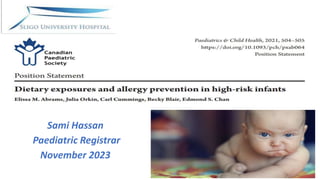
Dietary exposure and allergy prevention in high risk infants
- 4. Defining risk There is no international agreement on the definition of infants at high risk for food allergy development. The CPS practice point defines an infant at high risk as having either a personal history of atopy or a first-degree relative (at least one parent or sibling) with an atopic condition (such as asthma, allergic rhinitis, food allergy, or eczema) [7]. It is important to remember, however, that food allergy can occur in infants with no specific risk factors [23].
- 5. Introduction • The self-reported prevalence of food allergy in Canada is approximately 6% [1], and food allergy has increased over the past few decades [2]. • Recent evidence suggests that preventing the development of food allergies in infants is possible. • Several studies [3][4], and one meta-analysis [5], have supported the early introduction of allergenic foods (in particular peanut and cooked egg) as a means of preventing allergies to those foods.
- 6. Breastfeeding, and maternal diet during pregnancy and lactation • The available research trials examining the role of maternal allergen ingestion during pregnancy and lactation are observational studies that have demonstrated inconsistent results. • Systematic reviews of these observational trials have shown no link between maternal dietary intake and food allergy outcomes in children [24][25]
- 8. • Some study authors have noted limitations of methods, analysis, and inclusion criteria that have hampered results [26], with one recent systematic review concluding there was “no good evidence to recommend that pregnant or breastfeeding women should change their diet to prevent allergies in infants at high or normal risk” [26][27] Breastfeeding, and maternal diet during pregnancy and lactation
- 10. Choice of formula • There is insufficient evidence at this time to advise on the use of specific formulas, such as hydrolyzed formulas, for allergy prevention. • To prevent atopic conditions generally, previous guidelines have recommended the use of hydrolyzed formulas when mothers could not, or chose not to, breastfeed [6][18]. • However, a recent Cochrane review found no evidence to support short-term or prolonged hydrolyzed formula feeding (compared with exclusive breastfeeding) to prevent atopic disease [38].
- 11. • Regarding cow’s milk formula specifically, three observational studies have documented increased risk for developing cow’s milk allergy with delayed or irregular ingestion of cow’s milk early in life [39]-[41]. Choice of formula
- 12. • One recent RCT of 504 infants in Japan found that ingesting a minimum of 10 mL of cow’s milk formula at least once every day (compared with avoiding cow’s milk formula supplementation) at 1 to 2 months of age significantly reduced cow’s milk allergy at 6 months of age (0.8% versus 6.8%, risk ratio (RR) 0.12, 95% confidence interval (CI) 0.01 to 0.50; probability (P)<.001). Choice of formula
- 13. Introducing solid foods • Several observational studies have found an association between early ingestion (at less than 6 months of age) of a specific food allergen (in particular cow’s milk, egg, and peanut) and lower rates of allergy to that food in childhood [43][45]. Studies conducted since 2013, including RCTs, have provided convincing evidence for the early introduction of allergenic foods to prevent food allergy in high-risk infants.
- 14. • A significant ‘leap’ forward in this field was the Learning Early About Peanut (LEAP) study in infants at high risk for peanut allergy [3], which randomized 640 infants with severe eczema or egg allergy (or both) to either early peanut ingestion (at 4 to 11 months) or avoidance until 5 years of age. Introducing solid foods
- 15. • Results demonstrated an 80% reduction in peanut allergy with early peanut ingestion [3]. • The LEAP study found a preventative effect in both skin test-negative (13.7% versus 1.9%; P<.001) and skin test- positive infants (35.3% versus 10.6%; P=.004), which supported early peanut introduction as a means of both primary and secondary prevention. Introducing solid foods
- 16. Pre-emptive screening 4. High rates of clinically irrelevant positive test results 2. Lack of infant oral food challenges 3. Long waiting lists 1.Low cost effectiveness
- 17. Recommendations •Consider infants at high risk for food allergy when they have a personal history of atopy or a first-degree relative (at least one parent or sibling) with an atopic condition (such as asthma, allergic rhinitis, food allergy, or eczema). •Promote and support breastfeeding for up to 2 years and beyond, regardless of issues pertaining to food allergy prevention. •There is still insufficient evidence to recommend modifying the maternal diet to prevent food allergy (i.e., by avoiding or ingesting particular allergenic foods during pregnancy and while breastfeeding). •For mothers who cannot or choose not to breastfeed, hydrolyzed formulas should not be recommended to prevent atopic conditions (e.g., eczema, asthma, allergic rhinitis) in either high- or low-risk infants.
- 18. •Intermittent supplementation with intact cow's milk formula (e.g., a few bottles in the hospital followed by exclusive breastfeeding) should be avoided due to increased risk of cow's milk allergy. •For high-risk infants, encourage the introduction of allergenic foods (e.g., cooked (not raw) egg, peanut) early, at about 6 months and not before 4 months of age, in a safe and developmentally appropriate way, at home. In infants at low risk for food allergy, allergenic foods can also be introduced at around 6 months of age. Recommendations
- 19. •New foods, including commonly allergenic foods, can be introduced on successive days, with no evidence of harm to this approach. •When allergenic foods have been introduced, make sure that ongoing ingestion of age-appropriate serving sizes is regular (i.e., a few times a week), to maintain tolerance. •Pre-emptive screening for infant food allergies is not recommended. Families should be counseled that the risk of a severe reaction on the first exposure to an allergen is extremely low. •There is currently insufficient evidence to recommend vitamin D, omega 3, or pre- or probiotic supplements to prevent food allergies in infants. Recommendations